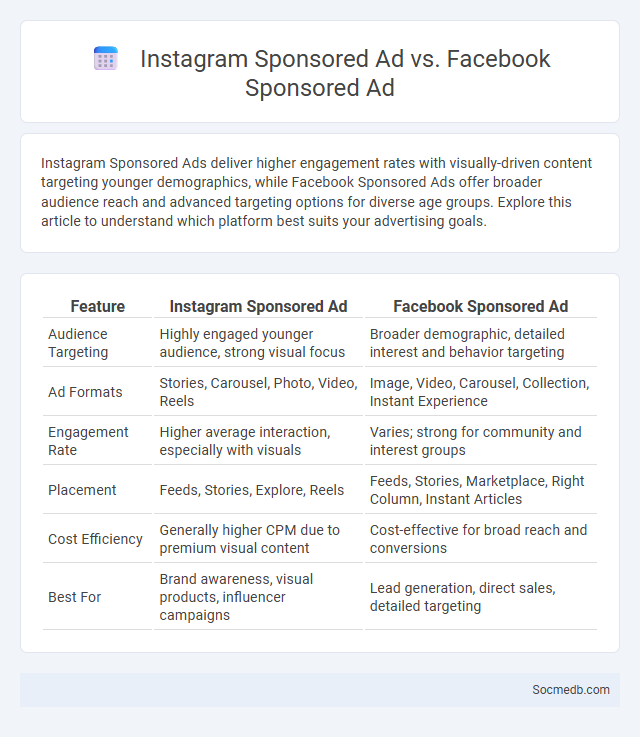
Photo illustration: Instagram Sponsored Ad vs Facebook Sponsored Ad
Instagram Sponsored Ads deliver higher engagement rates with visually-driven content targeting younger demographics, while Facebook Sponsored Ads offer broader audience reach and advanced targeting options for diverse age groups. Explore this article to understand which platform best suits your advertising goals.
Table of Comparison
| Feature | Instagram Sponsored Ad | Facebook Sponsored Ad |
|---|---|---|
| Audience Targeting | Highly engaged younger audience, strong visual focus | Broader demographic, detailed interest and behavior targeting |
| Ad Formats | Stories, Carousel, Photo, Video, Reels | Image, Video, Carousel, Collection, Instant Experience |
| Engagement Rate | Higher average interaction, especially with visuals | Varies; strong for community and interest groups |
| Placement | Feeds, Stories, Explore, Reels | Feeds, Stories, Marketplace, Right Column, Instant Articles |
| Cost Efficiency | Generally higher CPM due to premium visual content | Cost-effective for broad reach and conversions |
| Best For | Brand awareness, visual products, influencer campaigns | Lead generation, direct sales, detailed targeting |
Introduction to Sponsored Ads
Sponsored ads on social media target specific audiences using advanced algorithms to increase engagement and brand visibility. You can customize campaigns based on demographics, interests, and behaviors to maximize ROI. Leveraging platforms like Facebook, Instagram, and LinkedIn ensures your ads reach users most likely to convert.
What is an Instagram Sponsored Ad?
An Instagram Sponsored Ad is a paid promotion designed to increase your content's visibility beyond your current followers by targeting specific audiences based on demographics, interests, and behaviors. These ads appear seamlessly within users' feeds, stories, or explore pages, utilizing Instagram's advanced algorithm to maximize engagement and conversion rates. Utilizing Instagram Sponsored Ads allows you to strategically boost brand awareness, drive website traffic, and generate leads with measurable analytics.
What is a Facebook Sponsored Ad?
A Facebook Sponsored Ad is a paid advertisement on the Facebook platform designed to reach targeted audiences based on demographics, interests, and behaviors. These ads appear in users' news feeds, stories, or sidebar and are optimized to increase brand awareness, website traffic, or conversions. Advertisers use Facebook's robust analytics and targeting tools to maximize ad performance and achieve campaign objectives efficiently.
What is a Generic Sponsored Ad?
A Generic Sponsored Ad is a paid promotional content on social media platforms designed to reach a broad audience without targeting specific demographics or interests. These ads use generalized messaging and visuals to appeal to a wide range of users, increasing brand visibility and awareness. Leveraging platforms like Facebook, Instagram, and Twitter, they aim to drive traffic, engagement, and conversions from diverse user groups.
Audience Targeting: Instagram vs Facebook vs Generic
Instagram offers highly visual content targeting, ideal for brands engaging younger audiences through images and Stories, using features like Instagram's Explore and hashtag algorithms. Facebook provides robust demographic and interest-based targeting, utilizing extensive data to reach diverse age groups across its platform and affiliated apps. Your choice should align with your audience's preferences and engagement habits to maximize campaign effectiveness across these social media channels.
Ad Formats: Comparing Instagram, Facebook, and Generic Sponsored Ads
Instagram excels in visual storytelling with ad formats like Stories, Carousels, and Shopping Tags, driving high engagement through interactive elements. Facebook offers diverse ad types including Video Ads, Lead Generation, and Dynamic Product Ads, targeting precise demographic segments via the Facebook Pixel. Generic sponsored ads span multiple platforms, emphasizing native integration and broad reach but often lack the tailored interactivity found in Instagram and Facebook's specialized formats.
Cost and ROI: Instagram vs Facebook vs Sponsored Ads
Analyzing cost and ROI for social media campaigns reveals Instagram often delivers higher engagement rates but at a slightly increased cost per click compared to Facebook. Sponsored ads across both platforms can be finely targeted, yet Facebook's broader user base typically offers a lower cost per acquisition, maximizing returns for diverse marketing goals. By optimizing your budget allocation between Instagram and Facebook sponsored ads, you can enhance your campaign's effectiveness and achieve superior ROI.
Engagement Rates and Conversion Metrics
Engagement rates on social media measure the level of interaction--likes, comments, shares, and clicks--between users and content, serving as a critical indicator of audience interest and content effectiveness. Conversion metrics track the percentage of users who complete a desired action such as making a purchase, signing up for a newsletter, or filling out a lead form, directly linking social media activity to business outcomes. High engagement rates often correlate with improved conversion rates, indicating successful user engagement strategies and compelling call-to-actions.
Pros and Cons: Instagram, Facebook, and Generic Sponsored Ads
Instagram offers visually-driven engagement, boosting brand awareness through targeted ads and influencer partnerships, but its algorithm changes can limit organic reach. Facebook provides extensive audience targeting and diverse ad formats, making it effective for both B2C and B2B marketing, yet concerns about data privacy and declining younger user demographics present challenges. Generic sponsored ads across platforms allow precise targeting and scalability, but ad fatigue and rising costs require careful budget management and continuous creative optimization.
Which Sponsored Ad Platform is Best for Your Brand?
Choosing the best sponsored ad platform for your brand depends on target audience demographics, campaign goals, and budget allocation. Facebook Ads offer advanced targeting options and extensive reach across diverse age groups, while Instagram Ads excel in visual storytelling for younger, trend-focused consumers. LinkedIn Ads provide robust B2B targeting capabilities, making them ideal for professional services and niche markets.
 socmedb.com
socmedb.com